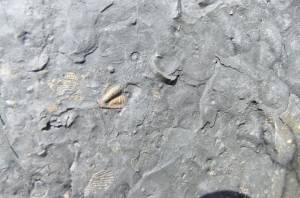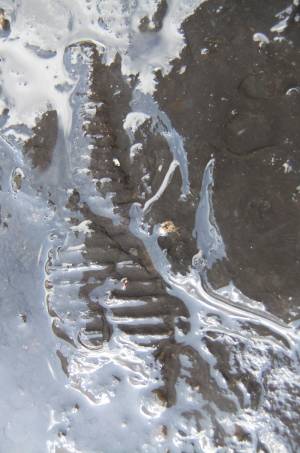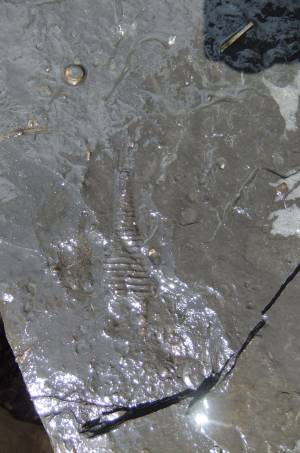|
| *****SWAAG_ID***** | 530 |
| Date Entered | 20/05/2012 |
| Updated on | 21/05/2012 |
| Recorded by | Tim Laurie |
| Category | Geological Record |
| Record Type | Geological HER |
| Site Access | Public Footpath |
| Record Date | 16/05/2012 |
| Location | Stainmore. Gilmonby Parish. Sleightholme Beck. |
| Civil Parish | Not known |
| Brit. National Grid | Hidden |
| Geology | Actively eroding fossiliferous mudstones of Middle Carboniferous Age in cliff over limestone pavement (formed by the top of the Four Fathom Limestone which is the equivalent to the Underset Limestone of the Askrig Block)in stream bed. |
| Record Name | The last of the Trilobites! |
| Record Description | Extract from the University of Wales Website:
'By the Carboniferous Period, only one order of trilobites, the Proetida, remained. Two superfamilies are represented, the Proetoidea and Aulacopleuroidea. It has been traditionally assumed that only a handful of trilobite genera are present in Carboniferous rocks, but well over sixty are now recognized. Certain facies in the Carboniferous in Britain contain an abundance of trilobites, with maximum diversity being achieved in carbonate mudmounds, as developed, for example, in the Craven area of North Yorkshire, in the Peak District and in north Wales. The only monographic treatment was published 120 years ago, and is now very much out of date, and a new monograph was started in the late 1980s. Work is well on towards its completion. Much of the data gathered will be used in the revised trilobite volume of the Treatise on Invertebrate Paleontology (q.v.).' |
| Geographical area | Stainmore |
| Additional Notes | Fragments of the chacteristic cast trilobate shells of very small Trilobites occur in shales at several localities in the NE Pennine Dales. The mudstone in which these fossils are extremely fragile and are constantly being eroded by floods from the cliff sections in which they occur.
Other species present in the mudstones here include crinoids, brachiopod shells and the very small Carboniferous Polyzoan, Fenestella sp.
The other fossil (?the crinoid Woodocrinus macrodactylus)photographed in these mudstones is found at several localities on Stainmore. |
| Image 1 ID | 2926 Click image to enlarge |
| Image 1 Description | Three triobites on slab of mudstone in stream bed. |  |
| Image 2 ID | 2927 Click image to enlarge |
| Image 2 Description | |  |
| Image 3 ID | 2928 Click image to enlarge |
| Image 3 Description | |  |
| Image 4 ID | 2929 Click image to enlarge |
| Image 4 Description | ?The crinoid Woodocrinus macrodactylus |  |
| Image 5 ID | 2930 Click image to enlarge |
| Image 5 Description | ?The crinoid Woodocrinus macrodactylus |  |
| Image 6 ID | 2931 Click image to enlarge |
| Image 6 Description | ?The crinoid Woodocrinus macrodactylus |  |
| Image 7 ID | 2932 Click image to enlarge |
| Image 7 Description | ?The crinoid Woodocrinus macrodactylus |  |
| Image 8 ID | 2939 Click image to enlarge |
| Image 8 Description | Sleightholme Beck. Fossiliferous mudstones in low cliff above the Four Fathom Limestone in bed of stream. |  |







